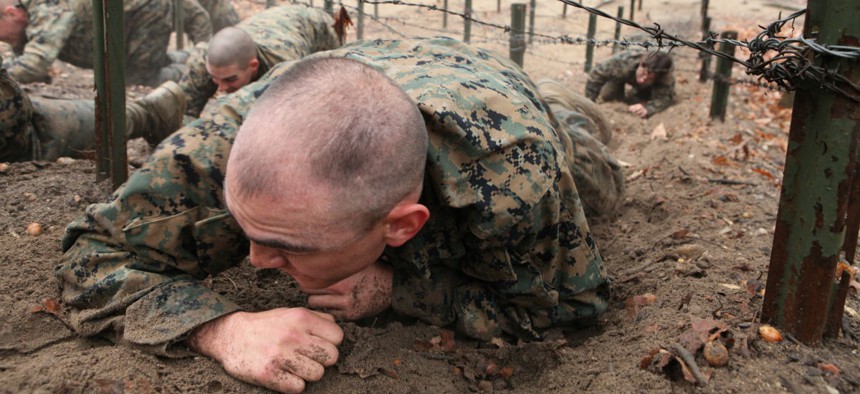How a Marine Confronts Fear, and Overcomes It
You’re not special—everyone’s afraid of something.
Fear took ahold the second I laid eyes on what they called the “confidence course.” There wasn’t anything to be confident about, as I listened to how we would maneuver our bodies across a couple of acres of what appeared to be instruments of the Middle Ages.
I was afraid and thought to myself, “You really did it this time . . . it’s over!”
I grew up afraid of heights. Deathly afraid of heights. I didn’t have a problem getting into an airplane and seeing the world from 20,000 feet. But if you put me on a stool to change a light bulb, I would start shaking instantly. And now, the day of reckoning had arrived at age 24. The Marine Corps instructors evaluating my potential to lead Marines had somehow placed me in a situation where I had to face and overcome my biggest weakness—the fear of high places.
As the supremely fit Marine instructor finished explaining and demonstrating each of the obstacles to our group of officer candidates—college graduates, some with graduate degrees and law degrees in their pockets—I did what I usually did to calm myself when faced with adversity. I took a few deep breaths, looked around, and reminded myself that I was not special. Everyone—and I mean everyone—fears something. I looked at my fellow officer candidates and saw myself. Their eyes were wide, yet focused. And they were determined to face their fears.
The genius of the obstacle course was that it was not designed for the confident, but to build confidence in those who had not yet faced their fears. Over a few weeks leading up to this point in the course, Officer Candidates School instructors had systematically been building and strengthening our bodies, and more importantly, our minds. The goal was to get us to a point where we wouldn’t be paralyzed by fear by simply looking at the obstacles on the confidence course.
Our goal was to complete the course while maintaining our bearing, using the correct techniques, doing it safely, remaining confident in our abilities and managing our fear. To be clear, we were being evaluated on our leadership potential—all part of what essentially is a 10-week interview so challenging that, on average, only 50 percent of those who start the process complete it. A passing grade on this particular day meant simply completing the course without major injury and with one’s shoulders and back a little bit straighter—confidence.
I stepped off, my leather combat boots striking the morning dew-drenched grass, found only in Quantico, with determination. The winter air filled my lungs and fueled the muscles in my legs and arms. I would do what I had always done: Face my fears. When I arrived at the bottom of the first obstacle, which required me to climb skyward, I didn’t pause. I just started to climb . . . and I continued to climb. Keep climbing.
Raphael Hernandez is a marketing and talent acquisition executive at Amtrak, and a Marine Corps veteran.
NEXT STORY: Why Aren't Intelligent People Happier?



